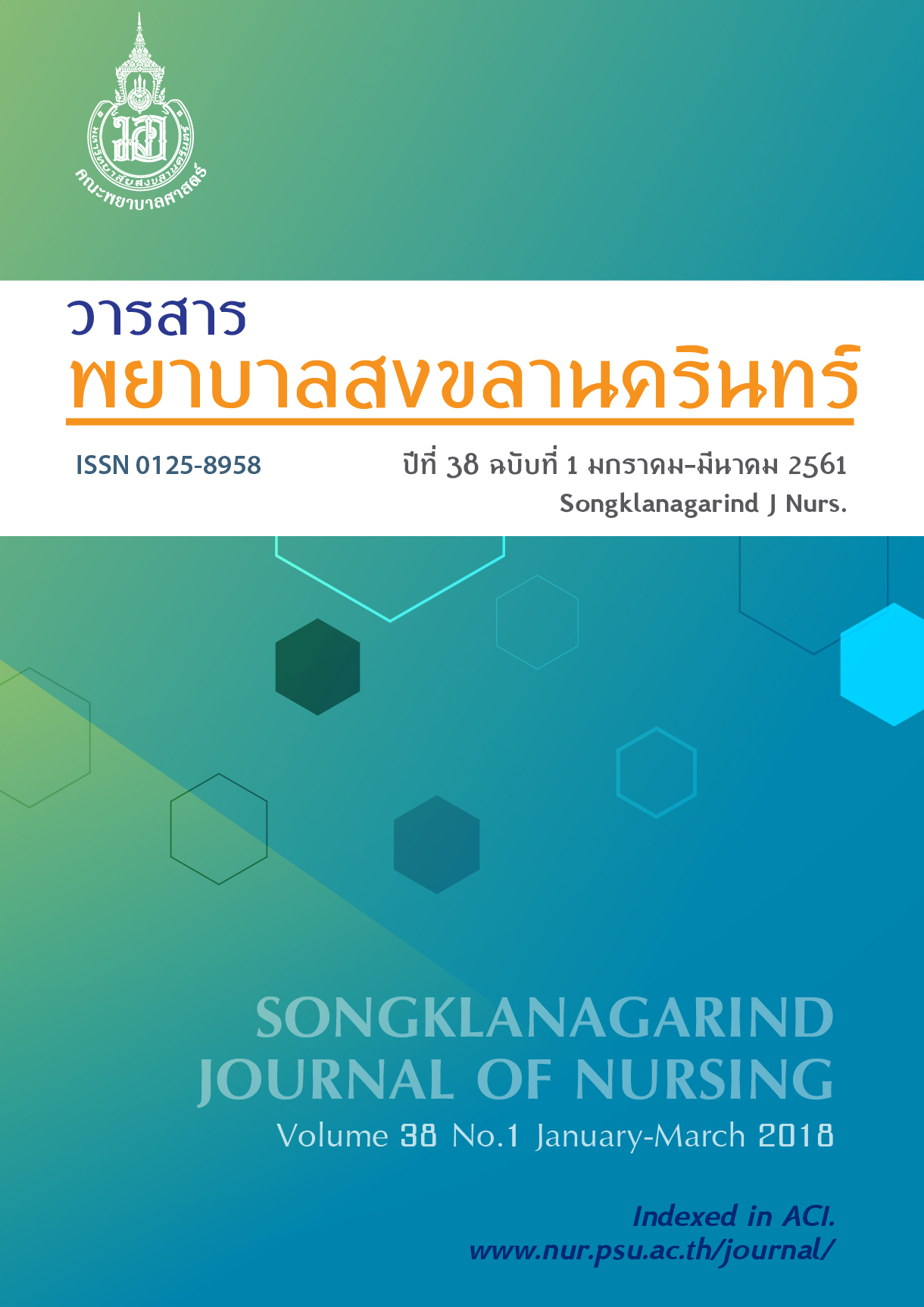Comparison of the Properties of Pain Assessment Tools Between the COMFORT-B Scale and the Modified FLACC Scale in Ventilated Sedated Children During Suctioning
Main Article Content
บทคัดย่อ
The aims of this descriptive study were to evaluate the construct validity by known group technique and multitrait-multimethod technique and to evaluate and compare the reliability of the COMFORT-B scale and the modified FLACC scale. Thirty two ventilated sedated children aged 1 month to 4 years were included in this study. Two nurses who passed training program about the pain assessment tools on the acceptable value of the inter rater reliability (ICC of COMFORT-B scale and modified FLACC scale = .98 and .94 respectively), observed each child from 10 VDOs simultaneously and assessed pain score using both scales before and during endotracheal closed system suctioning. Each period of observations was repeated three times. The personal data were analyzed by using descriptive statistic. The construct validity of known group technique data were analyzed by using a paired-sample-t test and multitrait-multimethod technique data were analyzed by Pearson’s product moment correlation. Inter rater reliability was assessed using the intra-class correlation coefficient (ICC).
The results revealed that the COMFORT - B and the modified FLACC scale showed construct validity as both scales discriminated pain before and during suctioning (t=-30.98, p< .001 and t=-28.06, p< .001 respectively) and also could measure pain because both scales were correlated (before suctioning r= .23, p= .024 during suctioning r= .73, p= .000). In addition, the inter rater reliability of both scales was equally excellent (ICC= .98).
The results showed that both scales, the COMFORT-B scale and the modified FLACC scale, have construct validity and reliability properties in assessing acute pain. This information can provide evidence base for nurses to choose the most appropriate pain scale to assess pain in children.
Article Details
เอกสารอ้างอิง
2. Bunburaphong T. Respiratory care in clinical practice. 4 th ed. Bangkok: Choraka Printing; 2013. Thai
3. Gillies D, Spence K. Deep versus shallow suction of endotracheal tubes in ventilated neonates and young infants. Cochrane Database Syst Rev. 2011;6(7). doi:10.1002/14651858.CD003309.pub2
4. Cury MR, Martinez FE, Carlotti AP. Pain assessment in neonates and infants in the post-operative period following cardiac surgery. Postgrad Med J. 2012; 89(1048):63-7. doi:10.1136/postgradmedj-2012-130808
5. Suominen P, Caffin C, Linton S, et al. The cardiac analgesic assessment scale (CAAS): A pain assessment tool for intubated and ventilated children after cardiac surgery. Paediatr Anaesth. 2004; 14(4):336-43. doi:10.1046/j.1460-9592.2003.01241.x
6. Plafor S, Jenkins I, Boyles C, et al. Consensus guidelines on sedation and analgesia in critically ill children. Intensive Care Med. 2006; 32(8):1125-36. doi:10.1007/s00134-006-0190-x
7. Dorfman TL, Schellenberg ES, Rempel GR, et al. An evaluation of instruments for scoring physiological and behavioral cues of pain, non-pain related distress, and adequacy of analgesia and sedation in pediatric mechanically ventilated patients: A systematic review. Int J Nurs Stud. 2014; 51(4):654-76. doi:10.1016/j.ijnurstu.2013.07.009
8. Von Baeyer CL, Spagrud LJ. Systematic review of observational (behavioral) measures of pain for children and adolescents aged 3 to 18 years. Pain. 2007; 127(1-2):140-50. doi:10.1016/j.pain.2006.08.014
9. Bai J, Hsu L, Tang Y, et al. Validation of the comfort behavior scale and the flacc scale for pain assessment in Chinese children after cardiac surgery. Pain Manag Nurs. 2012; 13(2):18-26. doi:10.1016/j.pmn.2010.07.002
10. Van Dijk M, Peters WB, Van Dijk P, et al. The comfort behavior scale: A tool for assessing pain and sedation in infants. Amer J Nurs. 2005; 105(1):33-6.
11. Ambuel B, Hamlett KW, Marx CM, et al. Assessing distress in pediatric intensive care environments: The comfort scale. J Pediatr Psychol. 1992; 17(1): 95–109.
12. Johasson M, Kokinsky E. The comfort behavioral scale and modified flacc scale in pediatric intensive care. Nurs Crit Care. 2009; 14(3): 122-30. doi:10.1111/j.1478-5153.2009.00323.x
13. Srisatidnarakul B. The methodology in nursing research. 5 th ed. Bangkok: U & I Intermedia;2010. Thai
14. Kitpreedaborrisut B. Construction and efficiency of the instrument 7th ed. Bangkok: Si Anan Printing; 2006. Thai
15. Polit DF, Hungler BP. Nursing research principles and methods. 6th ed. Philadelphia: Lippincott;1999.
16. Wiroonpanich W. Nursing for pain management in post operative children with limited communication by insert endotracheal tube. Songkhla: Faculty of Nursing, Prince of Songkla University; 2016. Thai
17. Narktim K. Pediatric sedation score: The clinical nursing practice guideline for pediatric pain management in PICU Hatyai hospital. Songkhla;2010. Thai
18. Samitivej W. Pain management in infants and children. In: Prechawai C, Prasartwanakit A, Petpichetchian W, editor. Pain and pain management in special population. Songkha: Chanmuang Press;2007. Thai
19. Hallgren KA. Computing inter-rater reliability for observational data: An overview and tutorial. Tutor Quant Methods Psychol. 2012; 8(1):23–34.
20. Nasae T. The efficiency of nursing instrument. Songkhla: Tame printing; 1999. Thai


